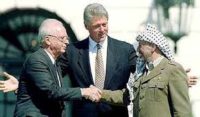Track Two Diplomacy
 As I sit down to draft the policy sections of the conflict resolution and peacebuilding textbook I’m writing with Doug Irvin-Erickson, I find myself having to come to grips with one of the most important concepts in our field Track Two diplomacy, which also happens to be one of its most elusive. This post is not designed to be a comprehensive overview. For that, look at Peter Jones’ Track Two Diplomacy in Theory and Practice on the subject which I have reviewed elsewhere.
As I sit down to draft the policy sections of the conflict resolution and peacebuilding textbook I’m writing with Doug Irvin-Erickson, I find myself having to come to grips with one of the most important concepts in our field Track Two diplomacy, which also happens to be one of its most elusive. This post is not designed to be a comprehensive overview. For that, look at Peter Jones’ Track Two Diplomacy in Theory and Practice on the subject which I have reviewed elsewhere.
What It Is
 The term Track Two was apparently first coined by Joseph Montville who was then a Foreign Service Officer at the U.S. State Department. As he and many other Track Two advocates see it, formal diplomats do not have a monopoly on the skills needed for successful negotiations. In fact, there are times when others are better suited to moving those discussions forward. Jones sums such discussions up as:
The term Track Two was apparently first coined by Joseph Montville who was then a Foreign Service Officer at the U.S. State Department. As he and many other Track Two advocates see it, formal diplomats do not have a monopoly on the skills needed for successful negotiations. In fact, there are times when others are better suited to moving those discussions forward. Jones sums such discussions up as:
The idea of bringing together small groups of influential people to quietly discuss things that could not be discussed officially, and including in those discussions people from countries that did not officially recognize each other and thus had few if any other means of communicating, struck a chord in me.
The scope of Track Two work has expanded dramatically over the years so that one NGO now refers to it at Multi-Track Diplomacy because participants can come from many walks of life, ranging from groups of American university presidents or jazz musicians meeting their counterparts in Iran. The logic behind almost all of these kinds of initiatives include:
- carefully selecting participants who both are open minded themselves and have connections to more powerful leaders
- carefully choosing facilitators who are skilled at getting people to begin to trust and talk with each other
- sometimes carefully choosing where the meetings take place so that each side is as comfortable as possible
- assuming that progress will come slowly and will require a number of sessions
- not every Track Two will lead anywhere. In fact, most of them do not
- a successful Track Two process that reaches an agreement is not enough. That single agreement is important, but the peace process has to continue until it addresses the root causes of the conflict
Track Two processes of one sort or another are almost always important for the reasons Peter Jones alluded to. Often, leaders of the officials on each side cannot and will not be seen talking to each other. Even if they are , it is easier for academics or artists to set the stage for what have to turn into formal intergovernmental relations. If nothing else, Track Two discussions bring adversaries into contact with each other. Indeed, one of the lessons from all of the negotiations I know of is that their success came only after participants began to see each other as real human beings rather than as stereotype-driven enemies.
Similarly, Track Two efforts succeed when they expand what conservative public policy experts call the Overton Window. Joseph Overton coined the term in the 1990s to define the range of positions policy makers considered acceptable at a given time. Since then, people have thought more in terms of shifting the “Overton window” so that different ideas get included in the list of “available options.” Put simply, successful Track Two efforts expand the Overton window and, in the process, make reframing the issues and, ultimately, reaching unprecedented agreements possible.
Recent research has shown that seemingly successful Track Two efforts that lead to a single agreement are never enough. Don’t get me wrong. Even partial agreements amid intractable conflicts are welcome. However, far too often, they become what Fen Osler Hampson calls “orphaned agreements” if the parties do not build on what they have accomplished and dig deeper into the root causes of the dispute.
Two Examples
The two best known examples of successful Track Two work illustrate how different these processes can be.
 Sometimes, they happen when small groups of private citizens who have close ties to official decision makers begin meeting with their counterparts on the other side to talk about specific issues in the hopes that they might “lead somewhere.” This is exactly what seems to have happened when a number of initiatives involving Israelis and Palestinians began in the early 1990s. These dealt with a number of specific issues, including the right of return for Palestinian refugees. They most famous and successful of these was hosted by Norwegians and led to the Oslo Accords of 1993 whose high point was the famous meeting on the White House lawn pictured here. The key here is that Arafat, Peres, and Clinton would never have been together than morning if relatively unknown leaders worked behind the scenes to bring the two sides closer together and expand the Overton window–thought they would never, of course, have used that term. Oslo was a remarkable agreement, but in the quarter century since them, we have seen more steps backward than forward. Indeed, as I write, most people I know who were involved in the peace process at the time are rather depressed about what the future could bring. There are lots of reasons why that’s the case, but any list has to include the rigidity of the thinking about options on the part of leaders on all sides, including the United States, a point I’ll talk about next week when I consider the implications of Leonard Mlodinow’s Elastic.
Sometimes, they happen when small groups of private citizens who have close ties to official decision makers begin meeting with their counterparts on the other side to talk about specific issues in the hopes that they might “lead somewhere.” This is exactly what seems to have happened when a number of initiatives involving Israelis and Palestinians began in the early 1990s. These dealt with a number of specific issues, including the right of return for Palestinian refugees. They most famous and successful of these was hosted by Norwegians and led to the Oslo Accords of 1993 whose high point was the famous meeting on the White House lawn pictured here. The key here is that Arafat, Peres, and Clinton would never have been together than morning if relatively unknown leaders worked behind the scenes to bring the two sides closer together and expand the Overton window–thought they would never, of course, have used that term. Oslo was a remarkable agreement, but in the quarter century since them, we have seen more steps backward than forward. Indeed, as I write, most people I know who were involved in the peace process at the time are rather depressed about what the future could bring. There are lots of reasons why that’s the case, but any list has to include the rigidity of the thinking about options on the part of leaders on all sides, including the United States, a point I’ll talk about next week when I consider the implications of Leonard Mlodinow’s Elastic.
 The other one was the Good Friday Agreement that was reached five years later in 1998. Track Two processes were less apparent in the final negotiations in 1997 and 1998, most of which were covered in the press and revolved official negotiators from the parties in Northern Ireland, the UK, Ireland, and the US. Indeed, it is hard to underestimate the effect that George Mitchell had as a mediator and the openness to change of new governments in the UK and Ireland. That should not keep us from seeing two things. First, Track Two efforts by low-level diplomats in the Irish Republic and UK as well as the impact of Irish-American activists paved much of the way for Mitchell and his team to do their work. Second, the Good Friday Agreement has stuck better than Oslo in part because people in Northern Ireland, Irish-American activists, and others committed themselves to working out conflicts and taking the two sides closer to reconciliation. Those reconciliation are, in fact, rather remarkable–even if they aren’t in the news all that often. They range from the investments made by the International Fund for Ireland to Kabosh, which is a theater company that does reconciliation related performances, including pub crawls and city tours.
The other one was the Good Friday Agreement that was reached five years later in 1998. Track Two processes were less apparent in the final negotiations in 1997 and 1998, most of which were covered in the press and revolved official negotiators from the parties in Northern Ireland, the UK, Ireland, and the US. Indeed, it is hard to underestimate the effect that George Mitchell had as a mediator and the openness to change of new governments in the UK and Ireland. That should not keep us from seeing two things. First, Track Two efforts by low-level diplomats in the Irish Republic and UK as well as the impact of Irish-American activists paved much of the way for Mitchell and his team to do their work. Second, the Good Friday Agreement has stuck better than Oslo in part because people in Northern Ireland, Irish-American activists, and others committed themselves to working out conflicts and taking the two sides closer to reconciliation. Those reconciliation are, in fact, rather remarkable–even if they aren’t in the news all that often. They range from the investments made by the International Fund for Ireland to Kabosh, which is a theater company that does reconciliation related performances, including pub crawls and city tours.
Why So Little Today?
You might ask why there seems to be so little Track Two work being done today.
Of course, there may be a lot of it going on that just hasn’t reached the media. If so, terrific. But, I haven’t even heard rumors of much of it taking place. So, it is worth asking why.
- We lack links to critical leaders despite years of working in the field in national capitols like Washington, London, and Moscow where this was common in earlier crises.
- Conversely, some government agencies have incorporated at least “first cousins” to Track Two work in their own repertoires, including the Conflict and Stabilization Office at the U.S. State Department and a number of offices at the U.S. Agency for International Development
- Peacebuilders are focusing more of their attention on other approaches, especially those emphasizing grassroots or local efforts
Still, as the simmering trade wars with Europe and China, the ongoing crises with North Korea and Iran, and the festering conflicts around the world suggest, a return to Track Two certainly seems in order.
The views and opinions expressed in this article are those of the author and do not necessarily reflect the official policy or position of the Alliance for Peacebuilding or its members.
Also published on Medium.





